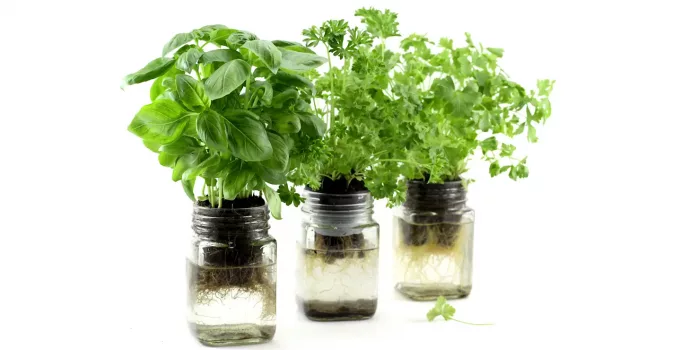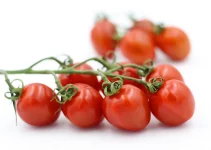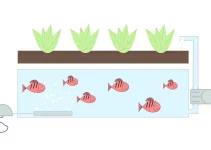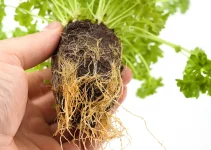Let me tell you all about the herbs to grow in hydroponics because it’s the perfect focus for beginners.
If you want to experiment with growing plants in just water and nutrients, there are two main categories to consider: herbs and leafy greens (hydroponic lettuce in particular).
Before dividing into this guide on herbs grown hydroponically, I’ve read in Hydroponics: A Beginner’s Guide to Building Your Own Hydroponic Garden by Tom Gordon that herbs grown hydroponically have 20 to 40% percent more aromatic oil, which is surprising indeed.
We all know that plants grown in a hydroponic system, grow more quickly and can produce more yield but I wasn’t aware that herbs can also produce more aromatic oil. It can be an attractive aspect for industrial growers.
I am in it for the taste and the faster growing rate. Although, I’m not opposed to growing potted herbs, either. Or growing them in the garden. Those conventional methods can be just as wonderful. As an example, check out my post on how to grow basil from seed.
Table of Contents
Herbs to Grow in Hydroponics: Best Systems for Beginners
1. Affordable: iDoo Hydroponics Growing System 12 Pods
This is an amazing hydroponic indoor garden that’s perfect for growing a variety of herbs. and leafy greens. If you get more adventurous, you can also try growing strawberries. The 12 pods offer enough space for a nice, varied herb garden grown on the kitchen counter. It comes with 50pcs growth sponges + baskets, grow lights, 4.5L reservoir, water pump, and nutrient solution. All you have to buy are the seeds. It’s also one of the cheapest AeroGarden alternatives.
2. Great brand: AeroGarden Harvest Elite
Is there a way to talk about herbs to grow in hydroponics and the best systems for beginners without mentioning AeroGarden? It’s the most famous manufacturer. We get 6 pods, grow sponges, grow lights, nutrient solution, alarms for water and nutrient solution. The plants can grow up to 12 inches tall, which makes it perfect for herbs and other small plants. If you want to grow taller plants (tomatoes, peppers) you’ll have to spend more for the AeroGarden Bounty.
3. Very expensive: Aerospring 27-Plant Vertical Hydroponics Indoor Growing System
This is not exactly a system for beginners. I would say that it’s a system for people who have grow accustomed to hydroponic systems like the iDoo and AeroGarden and they now want to experiment with a more complex system. And they have the money for it. The Aerospring is complex and we get 27 pods for growing plants. This is a vertical hydroponic tower that can grow everything: herbs, leafy greens, tomatoes, peppers, cucumbers, strawberries, etc.
Herbs to Grow in Hydroponics: General Conditions
1. Ph: the classic 5.5 to 6.5 pH range works well.
2. EC: an average EC of 2 is a general way to go – herbs are lower EC crops, just like leafy greens.
3. Grow lights: fluorescent (T5 bulbs) or full-spectrum LED grow lights are both great choices for herbs in general.
Most hydroponic herbs will require at least 10-12 hours under artificial lights (some might need 14 hours), which is the equivalent of 6-8 hours of natural light.
4. Temperature: at least 60 degrees Fahrenheit (15 degrees C) for temperature but 70 degrees Fahrenheit is more like the average for herbs (21 degrees C) and some will go for 80 degrees Fahrenheit.
5. Hydroponic nutrients: if you want to know everything about hydroponic nutrient solutions, check out my article on the best hydroponic nutrients.
Easy Herbs to Grow in Hydroponics
We can grow the following herbs in hydroponics:
- basil varieties
- mint varieties
- parsley
- oregano
- cilantro
- dill
- fennel
- sage
- chamomile
- anise
- catnip
- lavender
- marjoram
- rosemary
- thyme
- chives
- tarragon
I already wrote some very nice guides on how to grow hydroponic basil, hydroponic parsley, and hydroponic cilantro but I also want to make a complete roundup of all the herbs to grow in hydroponics. I’ll try to include as many as I can.
Once you have all this figured out and you have gone through the trials of growing lettuce and herbs hydroponically, you can move on to bigger things like growing hydroponic tomatoes, peppers, cucumbers, strawberries, blueberries, cabbage, beans, peas, cauliflower or even vegetables that grow in the ground like onions, potatoes, and carrots. It’s a very big universe.
For this complex article, let’s just focus on the topic of herbs to grow in hydroponics and the conditions they require.
1. Basil: One of the Most Popular Herbs to Grow in Hydroponics
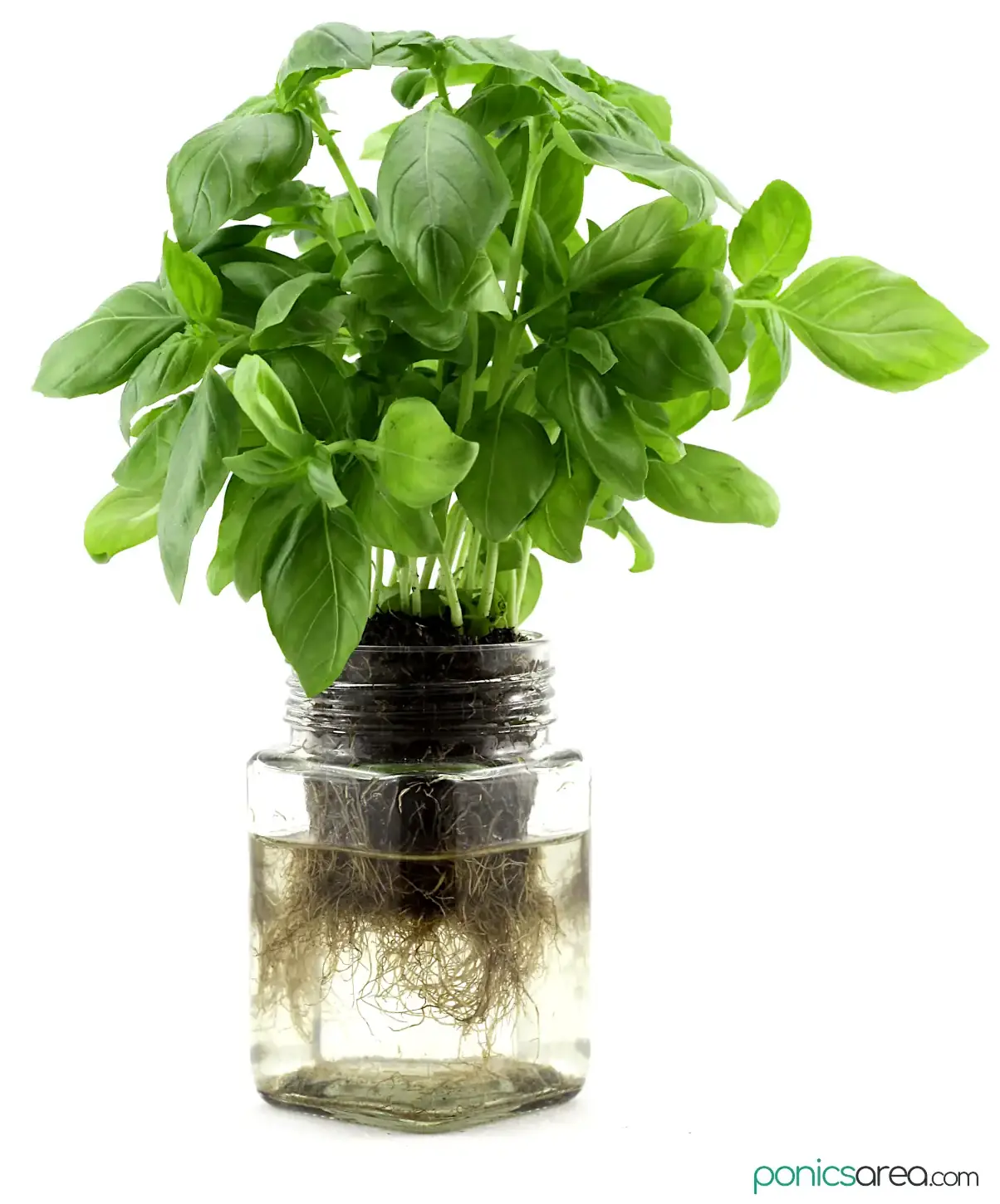
- thrives in any hydroponic system, even in a plastic bottle hydroponic wicks system (that goes for a large majority of herbs)
- it’s one of the most common herbs to grow in hydroponics
- it just needs water, nutrients, warmth, and plenty of sunlight/grow lights
- 5.5 to 6.5 pH (5.8-6.2 pH if you want to be really specific)
- EC of 2 or between 1.6 and 2.2 for a wider range or even as high as 2.5
- temperatures between 70 and 90 degrees Fahrenheit (21-32 degrees Celsius)
- 6-8 hours of sunlight or 10 to 12 hours under artificial lights
- germinate the seeds or grow from cuttings (propagation from cuttings speeds up the growing time)
- if you have experience with growing in a pot indoors or in the garden, you already know that you need to prune it – read when and how to prune basil for the first time, it applies to basil grown hydroponically, too
- prune it when it grows 6 inches tall (has 3/4/5 sets of true leaves) if you want to increase its yield and to postpone flowering, when it stops its growing cycle and the leaves get slightly bitter
- harvest weekly once it matures – you’ll be able to make so much pesto and all kinds of Italian dishes or Thai dishes as often as you have the time
2. Oregano: Needs a Higher pH
- 1.5-2.0 EC
- it will require a bigger pH than what you might be used to – a pH between 6.0 and 8.0
- grow it in 55-70 degrees Fahrenheit (approx. 13 to 21 degrees C) – it prefers colder weather
- it needs quite a lot of hours under grow lights: 14 hours lighting
- 3 main kinds of oregano: Greek, Mexican, and Italian
- Mexican oregano is quite different than the others and it’s really used just for Mexican dishes
- Greek and Italian are great for Mediterranean dishes – amazing for pizza alongside basil
- it’s just as good dried as it is fresh so, you can grow a bunch one time and dry it for future use throughout the year
- it can be ready for first harvest in 15 to 18 weeks and a second harvest in the following month
- cut back the flowers to continue the growing cycle
- you need to replant if it turns woody
3. Parsley: Lover of Natural Light
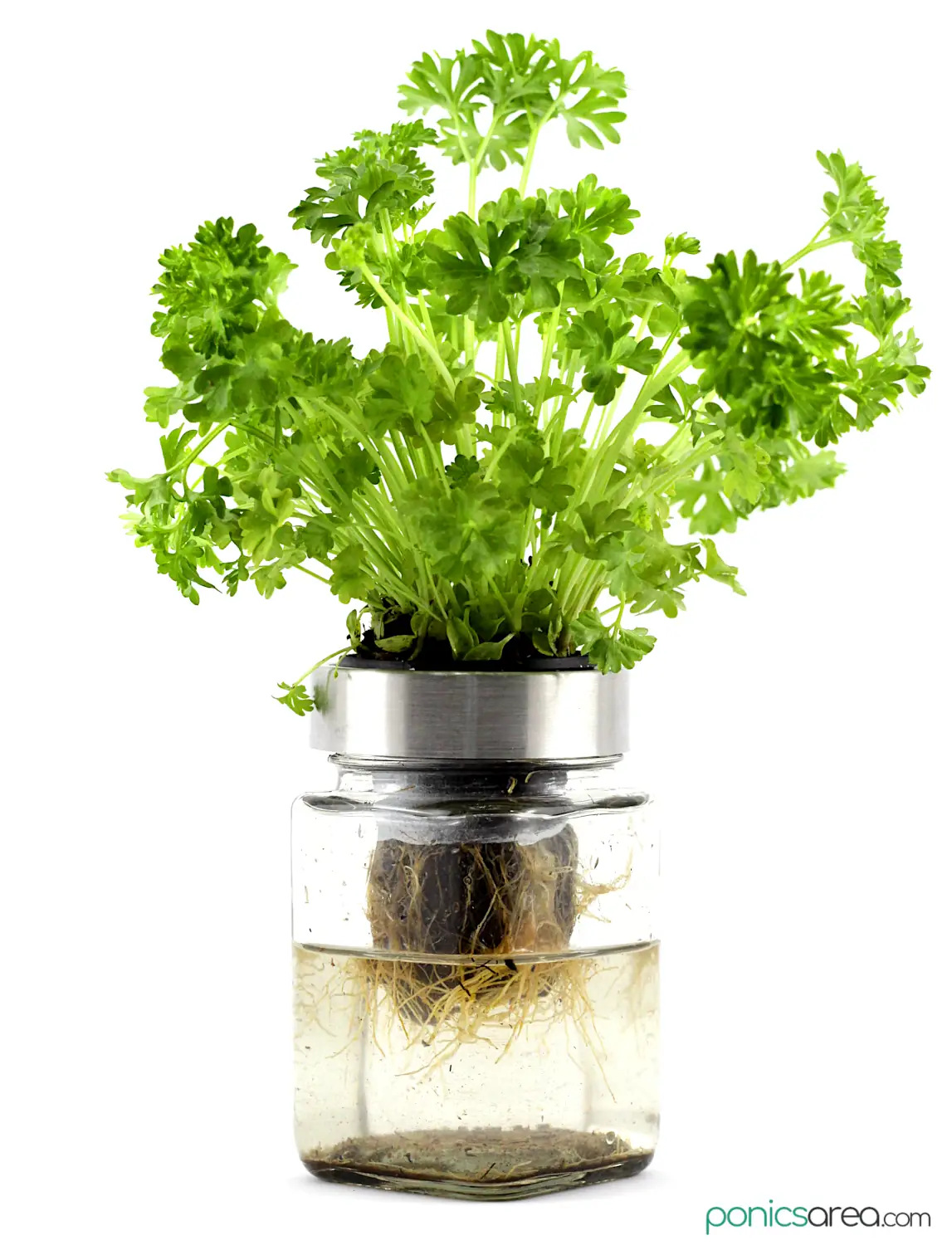
Hydroponic parsley grown using the Kratky method
- 6.0 to 7.0 pH (it can also grow in a 5.5–6.5 pH range)
- 0.8–1.8 EC
- 60 to 75 degrees Fahrenheit (15 to 25 degrees Celsius) – it prefers colder temperatures
- 10 hours under an artificial light but it’s a herb that actually prefers natural light (6-8 hours of sunlight)
- since it prefers natural light, it can be very easy to grow even in an apartment if you’re having a simple basic set-up like the Kratky method with mason jars or wicks plastic bottles – just place them on the window sill in the light
- if you want to speed up germination and ensure success, soak up the parsley seeds in tepid water for anywhere from 1 day up to 3 days or germinate them in paper towels for a couple of days
- the recommended temperature for germination is 68 to 77 degrees Fahrenheit (20 to 25 degrees C)
- can harvest in 20-30 days after transplanting or when the plant reaches at least 6 inches (15 cm)
- you can do the first harvesting by cutting the stems down to 2-3 inches from the growing medium
- after that, a second harvesting is possible in about 3 weeks
4. Cilantro: Needs Colder Temperatures
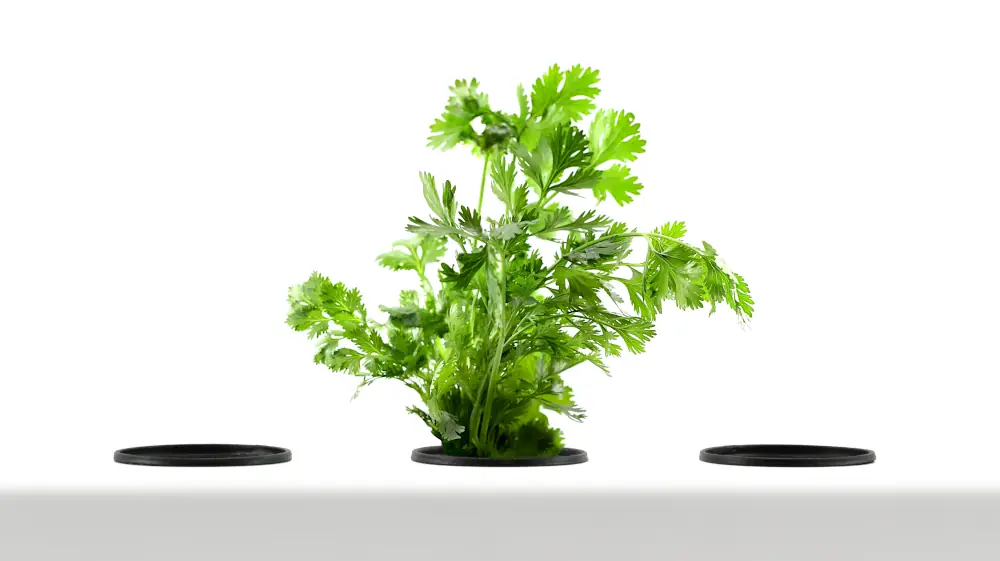 pH of 6.5 to 6.7 but the general ranges are the usual 5.5–6.5 pH
pH of 6.5 to 6.7 but the general ranges are the usual 5.5–6.5 pH- 1.6–1.8 EC
- 12 hours per day under grow lights
- it needs colder temperatures
- 50 to 70 degrees Fahrenheit temperature (10 to 21 degrees C) – even low temperatures of 40 degrees F can work very well
- in hot weather, cilantro is quick to bolt – that’s the major difficulty for this particular herb, how to stop it from quickly bolting
- all in all, cilantro is an easy herb to grow in hydroponics, any system works, as long as you maintain colder temperatures (due to that, it can be grown in a garage all year round)
- when the weather is too hot and you’re afraid of bolting, you can try growing microgreens without soil for cilantro and all the other herbs
- 7 to 10 days to germinate seeds
- temperature of 65–70 degrees F (18–21 degrees C) for germination
- harvest in 40-50 days
5. Mint: One of the Easiest Herbs to Grow in Hydroponics
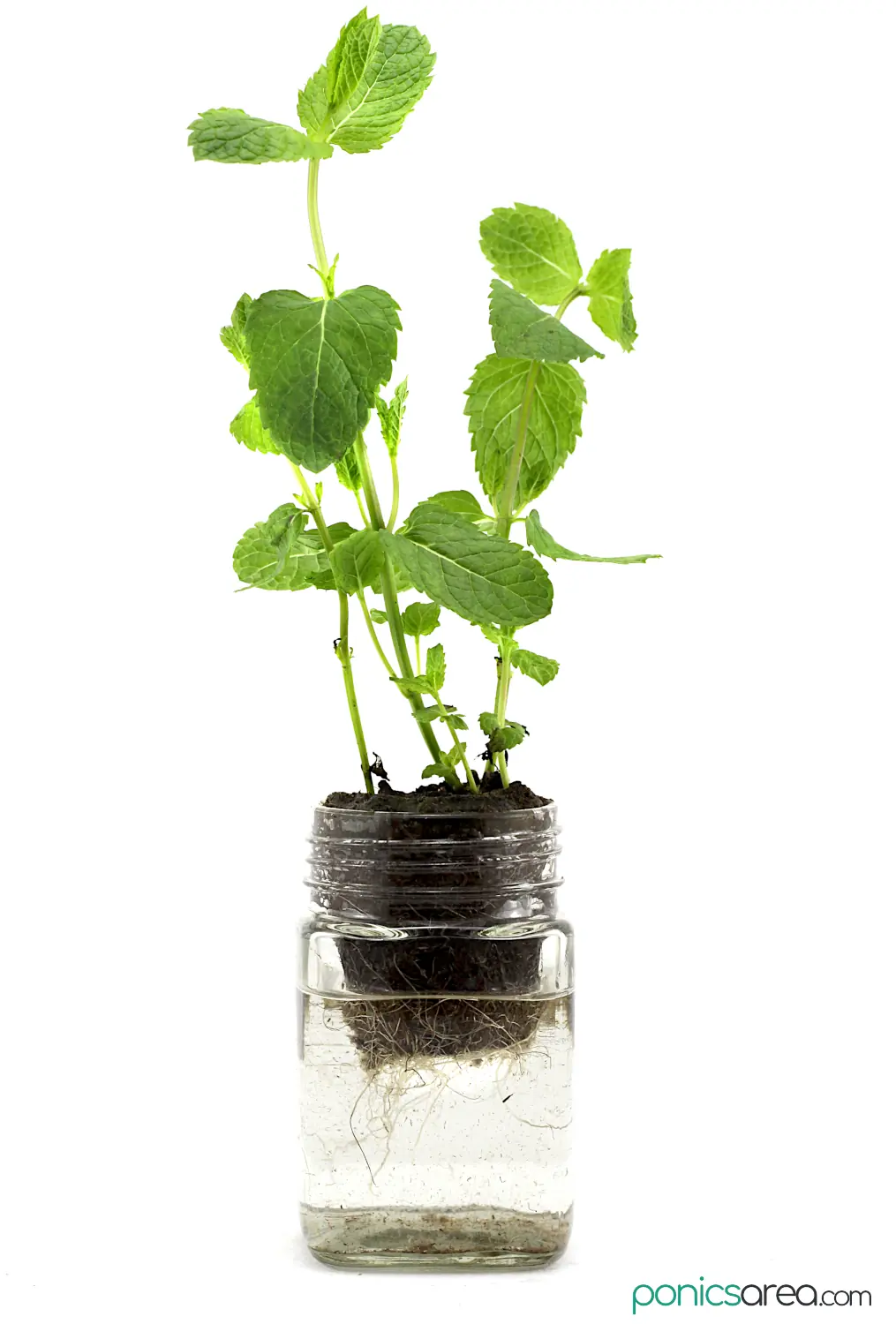 very easy to grow
very easy to grow- hydroponics is the perfect growing method for mint because this can be considered an aquatic or semi-aquatic herb
- even in a pot, mint needs to be watered pretty much daily or twice a day if the temperature gets really hot
- peppermint and spearmint are two of the most popular varieties to be grown in all kinds of systems
- when we’re saying mint, we’re actually referring to using the spearmint variety, especially for cooking and making desserts and beverages
- peppermint has a higher concentration of menthol so, it’s very intense, which makes it popular for flavoring and for its strong scent
- 6.5 to 7.0 pH
- 2.2 to 2.6 EC
- 65-70 degrees Fahrenheit (18 to 21 degrees C)
- 14-16 hours of lighting a day
- grow it from cuttings, rootstock or germinate seeds in 10 to 15 days at room temperature or slightly warmer
- you can harvest mint 2-3 times during growing season or pick up leaves as you need them
6. Chives: Perfect Alternative to Green Onions
- if you don’t want to go into growing green onions, you can choose to grow hydroponically the perfect substitute: chives
- by the way, you can choose to grow green onions from bulb onions by just placing them in water, I wrote about it here
- chives are quite easy to grow and thrive as part of the herbs to grow in hydroponics
- 6.0 to 6.5 pH
- EC 1.8-2.4
- 65-80 degrees Fahrenheit (18 to 27 degrees C) – a flexible temperature range that can be achieved in different locations
- 14-16 hours of lighting daily
- the major advantage is that this plant is perennial – it can provide us with a continuous supply of fresh leaves to garnish our dishes
- with every harvest, the leaves get thicker
- the first harvest can happen quickly, within 2–3 weeks
- germination happens in 2 weeks at 70 degrees Fahrenheit (21 degrees C)
7. Dill: No Special Requirements
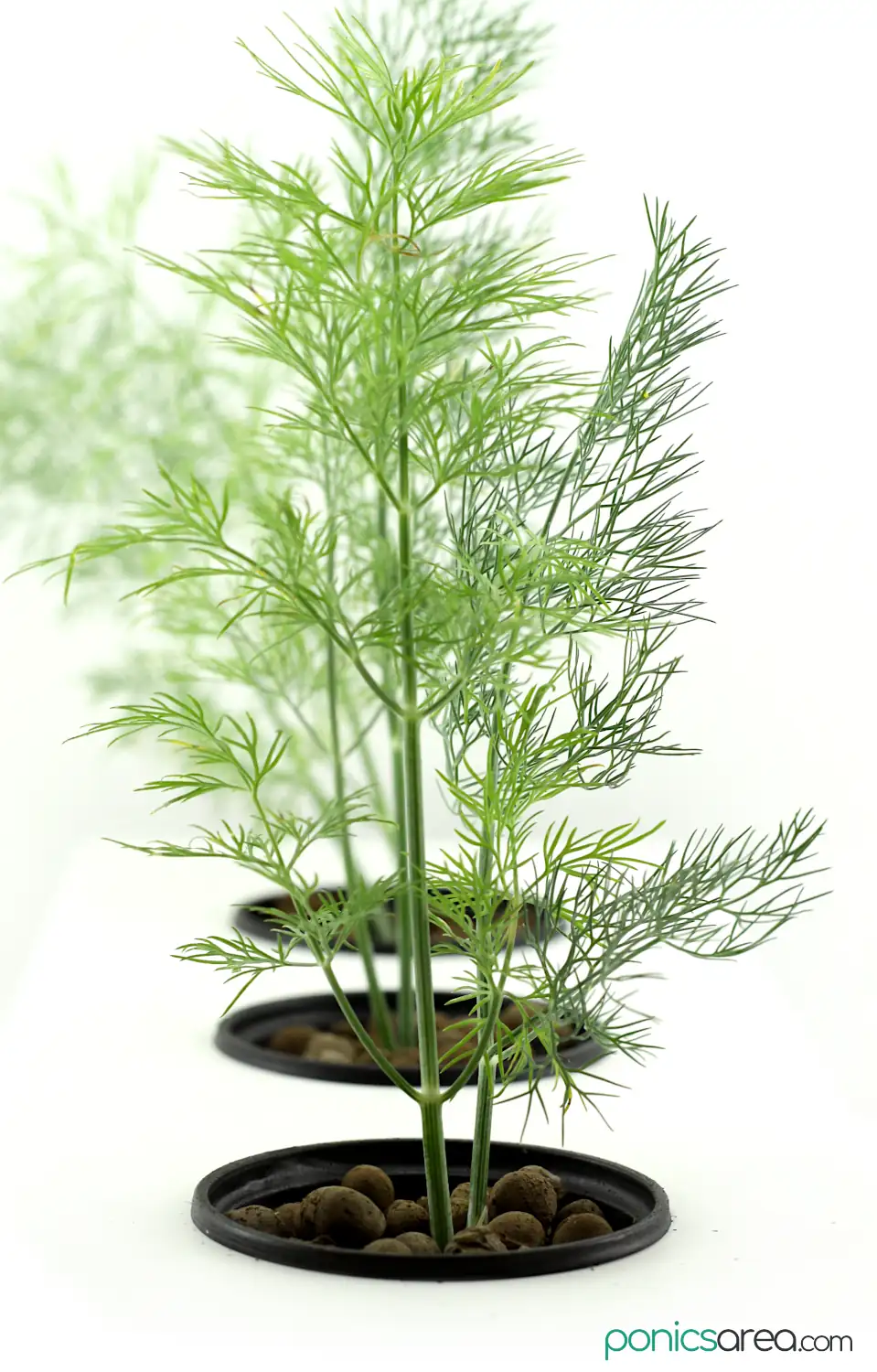
- those who love their seafood, love their dill in equal measures
- it’s also a must for pickles
- you shouldn’t miss on growing it in hydroponics because it’s quite easy
- 1.0 to 1.6 EC
- 5.5 to 6.4 pH range
- 65-80 degrees Fahrenheit (18 to 27 degrees C) temperatures
- 14 hours under artificial lights every day
- it produces new growth every time you harvest it
- you should thin it out regularly so that you don’t put pressure on the system in terms of water and nutrient consumption, it’s especially recommended if you’re growing a variety of herbs in the same system
- it will germinate in 7 to 15 days after sowing
8. Fennel: The Very Tall Herb to Grow in Hydroponics
- the herb that looks like dill but you can also consume the bulb – the bulbs can be consumed when they rich the size of a tennis ball
- the seeds should definitely be harvested when the plant ripens because they’re some of the most delicious
- you can also save the seeds for germinating and growing new plants
- the thing you must pay attention to when growing fennel, as opposed to most herbs to grow in hydroponics, is that it can reach 3-4 feet in height
- if you grow it properly, you can have your own fennel tower
- EC 1.0-1.4
- 6.4-6.8 pH
- 60-70 degrees Fahrenheit (15-21 degrees C)
- 10 hours under grow lights – one of the least demanding herbs in this respect
9. Sage: Matures Slowly
- amazing herb for meats
- EC 1.0-1.6
- 5.5-6.0 pH
- 75-85 degrees Fahrenheit (24-29 degrees C) – it’s a herb that loves warmth
- 14 to 16 hours daily of artificial light
- harvest before it blooms and dry the leaves
- it won’t lose its flavor even after flowering
- I wouldn’t recommend growing it from seed because it will take about 2 years to reach mature size
- it’s best to start from cuttings
- popular varieties are: Garden Sage, Purple Sage, Tri-color Sage, and Golden Sage
10. Chamomile
I admit, I don’t usually grow chamomile in my systems because I’m perfectly content with buying it whenever I’m in the mood for some soothing tea. And I also prefer drinking green tea or black tea daily.
However, I spent many summers picking chamomile from my grandparents garden so I do have a fondness for these beautiful plants.
I would say that those who want to grow a beautiful herb with pretty flowers and nice benefits will be very interested in chamomile as one of the best herbs to grow in hydroponics.
On the other hand, it’s not an easy herb to grow in hydroponics, not like all the other herbs I suggested above. So, maybe leave chamomile for soil cultures. Grab a nice pot, some good soil and try first growing it in soil.
Other herbs to grow in hydroponics are anise, catnip, lavender, marjoram, rosemary, thyme, and tarragon.
If you establish a pH around 6.0 and a warm to hot temperature, you can group basil, mint, and chives and grow them at the same time in the same system.
The Best Systems for Beginners to Grow Herbs Hydroponically
There are quite a few easy hydroponics systems that beginners can use in order to grow herbs hydroponically.
As easy set-ups for complete beginners in all hydroponic matters, we have:
- indoor gardens hydroponic systems (ready-made systems like the ones offered by AeroGarden and iDoo) – read everything you need to know in my article on the best hydroponic kits for beginners
- hydroponic mason jars (the Kratky method) – I also wrote a guide on mason jars hydroponics
- plastic bottle hydroponic wicks system – I included and described it in detail as a very cheap alternative to the best hydroponic systems
If you want to continue with the DIY route and you feel like you’re ready for more complex, bigger hydroponic systems, you have the following options:
DWC (deep water culture) system with a tote container
- absolutely great and cheap to build for apartments, garages
- a nice system for herbs to grow in hydroponics
- you can also grow leafy greens
- even strawberries and blueberries can be grown in this setup and some cherry tomatoes
- not good for big heavy plants but amazing for the rest
DWC system with floating polystyrene raft
Perfect for greenhouses because you can grow many type of plants in the polystyrene raft and you can use as big a container as the space allows you to.
5 gallon buckets DWC system
- quite inexpensive but offering immense versatility at the same time
- the 5 gallon bucket system can grow large vegetables and even citrus trees
- if you want to produce big crops, you will need many linked buckets, which will require a pretty big space
The container is the only thing that sets these 3 DWC systems apart. If you want to see how these set-ups should look like, just search on YouTube, there are so many tutorials there.
The principle is the same: the roots of the plants are immersed in water and nutrients. They take as much as they want, while they float on the water.
Net pots are used so, you have to make holes in the lid of the tote container or the lid of the bucket or the polystyrene raft.
Hydroton (expanded clay aggregate) is the preferred growing medium for these DWC systems, perfect for herbs to grow in hydroponics.
The seeds are germinated in rockwool cubes and transplanted with the cubes in the net pots.
There’s only a need for an air pump and an air stone to keep the water oxygenated. They all require grow lights.
DIY Complex Hydroponic Systems for Herbs and Much More
More complex systems that you can build at home are: NFT, ebb and flow, and drips.
These 3 will require the purchase of a hydroponic water pump, they’re more technical and need a bigger budget. The last two will require even more technical knowledge because they need a timer.
For many, the best system for herbs to grow in hydroponics is the ebb and flow. But I’m not going to state the same thing since this system is pretty hard to build and requires technical knowledge, as well.
The same goes for the drip hydroponic system. It’s awesome for growing herbs hydroponically but it’s not the easiest to build, unless you’re an experienced grower.
To give you a short introduction to the ebb and flow (flood and drain), these are the components that you’ll need:
- reservoir
- growing medium – a combination between expanded clay aggregate/growstones/lava rocks/pea gravel spread out throughout the grow bed, rockwool or coconut fiber for the roots
- grow trays
- water pump
- digital timer – it will tell the pump when to pump up the water in the grow bed and it will shut down the pump so that the excess liquids can return into the reservoir to be reused (the solution can be pumped for 15 mins every hour or two)
- plastic tubing – two tubes
- grow lights
It can fail due to 3 main factors: power outages, pump failure, and timer failure.
The NFT with PVC pipes is actually the easiest to build from these 3 complex models.
The other two options for herbs to grow in hydroponics are: aeroponics (not a lot of regular growers build them) and aquaponics (perfect for those who don’t mind learning about how to grow fish and plants at the same time).
Herbs to grow in hydroponics FAQs
Let’s answer a few questions related to this guide on herbs to grow in hydroponics.
1. What is the easiest to grow hydroponically?
My recommendation is that everyone should start with lettuce. It’s one of the easiest plants to grow in a hydroponic system of any kind and most of us start off with a lettuce variety, like butterhead lettuce, red leaf lettuce, loose leaf lettuce varieties but not iceberg. Then, we can move on to herbs, among which basil is definitely a top pick and one of the easiest to grow. But we can also grow mint, parsley, cilantro, oregano, etc. After that, if our hydroponic system allows, we can try to grow strawberries, tomatoes, cucumbers, peppers, etc.
2. Can you grow rosemary hydroponically?
Rosemary is a very deep rooted shrub. While rosemary is among the herbs that we can grow hydroponically, I don’t regard it as one of the easiest to grow in a hydroponic system. Personally, I prefer growing rosemary in planters. Even that is not as simple as growing basil or cilantro or mint in planters so I recommend checking up on what growing rosemary entails and then you can decide if you want to try growing rosemary in a hydroponic system. Personally, I would recommend other hers for hydroponics. On the other hand, AeroGarden has seed pod kits that include basil, oregano, thyme, rosemary and more so it’s definitely possible to grow rosemary hydroponically.
3. What herbs grow best in an AeroGarden?
The herbs that grow best in an AeroGarden are the same herbs we can grow in any other hydroponic system. The list of herbs to grow in hydroponics includes: basil varieties, mint varieties, parsley, oregano, cilantro, dill, fennel, sage, chamomile, anise, catnip, lavender, marjoram, rosemary, thyme, chives, and tarragon.

